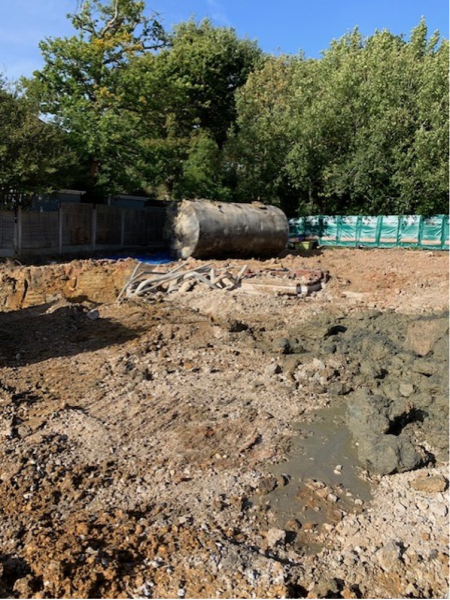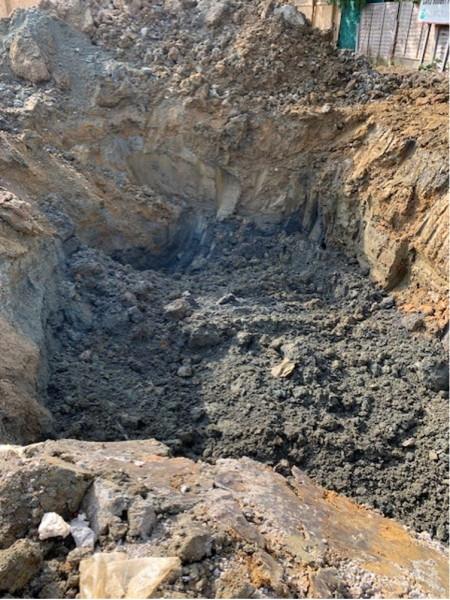Historic Usage Fuels Remediation Requirement
6th February 2024
Geoenvironmental • Geotechnical
Our Client

Preliminary-Assessment
In 2021, Ground & Water was instructed by its client – prior to the client purchasing the site – to carry out additional groundwater sampling in order to assess the risk posed by the contamination identified during the previous investigation. This monitoring identified concentrations at a lower level than previously recorded. That said, the concentration of heavy-end hydrocarbons (down gradient of main source) was noted to have increased.
Our Challenge
The site was occupied by a used car garage and was historically a re-fuelling station. The canopy of the former petrol station was present on-site. The presence of any below ground infrastructure (storage tanks, pipes, interceptors etc.) was not known at the time.
The Ground & Water Approach
During the initial site investigation, it was considered that groundwater was moving from northeast to southwest across the site and therefore the plume of hydrocarbons detected from sampling would migrate south-west as well. The light-end hydrocarbons (GRO) detected have a relatively low half-life when compared to the heavier-end hydrocarbons (DRO) meaning that they have the potential to degrade, whereas the heavier hydrocarbons may still be detected. The difference is as a result of the molecular chain lengths. Other effects include whatever biodegradation maybe occurring naturally within the groundwater.
As the heavier hydrocarbons are physically larger compounds they are often referred to as persistent hydrocarbons, as micro-organisms target the shorter chained hydrocarbons first. The lighter chain hydrocarbons are also considered to be more mobile within groundwater than the heavier-end versions. One uncertainty in differing data that cannot be ignored is the method of sampling. The original investigation used a bailer to obtain a sample. Bailers are now considered to be an old sampling method when compared to current standards, whereas in 2000 it was common practice to use them. Bailers are a simple device that obtains a grab sample of the top 1m of the water. The device is manually lowered on a rope and then withdrawn full of water. Bailers are not considered an appropriate means of sampling for VOCs and often cause agitation within the top of the water column, where dissolved hydrocarbons may be present. The rope is also considered a source of cross-contamination. In 2021 Ground & Water utilised a submersible pump, which removes water from the base of the borehole with minimal disturbance of water.
The risk assessment also indicated that there was residual TPH contamination within groundwater at the site as a result of the site history and was at a level where further investigation and remediation would be required.
Main Site Investigation (post purchase)
Primary aims were to investigate the contamination previously identified to formulate a subsequent remediation strategy and understand the geotechnical parameters for foundation design.
This comprised additional windowless sampling for provision of strength data as well as allowance for installation of two new monitoring wells to allow for a Detailed Quantitative Risk Assessment (DQRA) of the groundwater. In addition, a number of trial pits were dug to allow for retrieval of samples to be sent for contamination and geotechnical testing. Ground-gas monitoring was also required due the thickness of Made Ground encountered and the hydrocarbons known to be present beneath the site.
Due to the loads required for the proposed development it was determined a piled solution would be adopted so a deep cable percussion borehole was required to enable the pile design. As part of this a piling groundwater risk assessment was required. As the piles may extend into the aquifer beneath the site, the potential for preferential pathways created by the piling method needed to be considered.
 The DQRA comprised further groundwater sampling and concluded that the concentrations of contaminants in the groundwater at the site are not at a level that will cause an impact of the nearest surface water receptor. However, a degree of remediation was proposed in order to improve the quality of the aquifer within the areas of known historical contamination or contaminative sources, I.e. the underground fuel storage tanks in the south-west and oil-water interceptor in the north-east of the site. We advised that the locations that require additional treatment may increase following the enabling works, should any further significant contamination be identified.
The DQRA comprised further groundwater sampling and concluded that the concentrations of contaminants in the groundwater at the site are not at a level that will cause an impact of the nearest surface water receptor. However, a degree of remediation was proposed in order to improve the quality of the aquifer within the areas of known historical contamination or contaminative sources, I.e. the underground fuel storage tanks in the south-west and oil-water interceptor in the north-east of the site. We advised that the locations that require additional treatment may increase following the enabling works, should any further significant contamination be identified.
Gas monitoring was undertaken and concluded the site warranted a CS2 classification which would require ground-gas protection measures. Due to the volatile compounds identified during the groundwater testing it was determined that the membrane used as part of the ground-gas protection measures should be upgraded to protect against vapours as well.
The Outcome
 The investigation revealed that a degree of remediation was required at the site. This included a clean capping system in the proposed garden areas to protect human health; the decommissioning of monitoring wells on the site and removal of the underground storage tanks and placing of PetroFix at the base of the tank excavation. The PetroFix method removes hydrocarbons from the dissolved phase by adsorbing it onto activated carbon particles and then stimulates biodegradation by adding electron acceptors. This is a betterment approach for protecting controlled waters and also human health. Ground-gas/vapour protection measures required a vapour membrane and passive sub-floor dispersal layer to protect human health.
The investigation revealed that a degree of remediation was required at the site. This included a clean capping system in the proposed garden areas to protect human health; the decommissioning of monitoring wells on the site and removal of the underground storage tanks and placing of PetroFix at the base of the tank excavation. The PetroFix method removes hydrocarbons from the dissolved phase by adsorbing it onto activated carbon particles and then stimulates biodegradation by adding electron acceptors. This is a betterment approach for protecting controlled waters and also human health. Ground-gas/vapour protection measures required a vapour membrane and passive sub-floor dispersal layer to protect human health.
Ground & Water arrived at a cost-effective and sustainable remediation approach, which is currently on-going at the site. Validation of these measures will follow.
